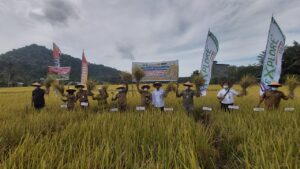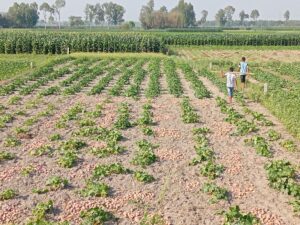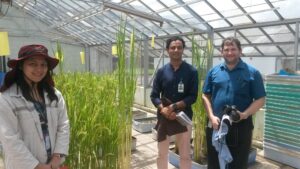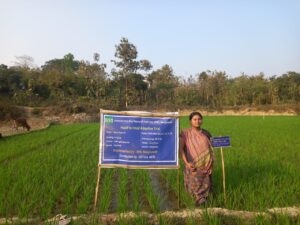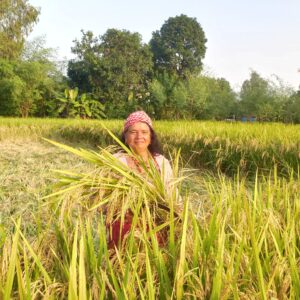
The Green Revolution that started in the early 1960s specifically focused on increasing rough rice yields globally by developing new, improved, high-yielding conventional varieties. But, it may be well worth noting that improving yields can also be achieved through simple and practical means, such as weed control.
Early control
Roy Smith, a former weed scientist at the University of Arkansas, documented that early-season grass and mid- to late-season broad leaf weed and sedge infestations affected rice yields the most. They directly compete with rice for nutrients, sunlight, space, and water; contaminate harvested grains; and even interfere in harvesting activities. Weeds can also indirectly affect yield by serving as reservoirs for insect and disease infestations.
Although removing weeds can be delayed, early action is advisable. Controlling them late in the growing season, which involves hand weeding or ground application of herbicides, can damage the crop (when farmers walk through the field), hence reducing yields.
Crop rotation
Continuous cropping of rice is commonly practiced for many reasons around the world. This, however, is not good. Growing rice after rice creates an environment favorable to weeds, especially types most competitive to rice, that is, weedy rice and the Echinochloa species. Rotating with an upland crop such as soybean, peanut, melon, mungbean, or sweet potato helps prevent weeds from thriving in the fields. A soybean-rice rotation, for example, has been proven useful in reducing weed pressure and increasing yield. Weeds can be controlled using the herbicide glyphosate in Roundup Ready soybeans (Glyphosate-resistant soybeans). Rotating to a legume also has the added benefit of replenishing nitrogen in the soil.
Secrets in planting
 Farmers could also keep in mind that every rice variety has an optimal planting rate (the best number of seeds that can be planted per area, allowing rice plants to later grow and maximize the space and prevent weed encroachment) at which it is most competitive with weeds. Planting too few seeds per hectare gives weeds space and time to grow and compete with rice. Hence, short-statured and semidwarf erect varieties need to be more densely planted to shade out and more aggressively compete with weeds. Furthermore, planting too few seeds per hectare forces rice plants to fill in more space by producing more tillers. If a rice plant produces a lot of tillers, the grains on the early tillers will ripen before the late ones and result in poor grain quality at the time of harvest.
Farmers could also keep in mind that every rice variety has an optimal planting rate (the best number of seeds that can be planted per area, allowing rice plants to later grow and maximize the space and prevent weed encroachment) at which it is most competitive with weeds. Planting too few seeds per hectare gives weeds space and time to grow and compete with rice. Hence, short-statured and semidwarf erect varieties need to be more densely planted to shade out and more aggressively compete with weeds. Furthermore, planting too few seeds per hectare forces rice plants to fill in more space by producing more tillers. If a rice plant produces a lot of tillers, the grains on the early tillers will ripen before the late ones and result in poor grain quality at the time of harvest.
Planting pregerminated seed onto exposed mud or into the water, then draining the field, is also a good practice as it gives the rice seeds a head start on germinating weeds. Once the rice has established a root system, it is beneficial to apply a preemergent herbicide in combination with a broad spectrum of contact herbicide before establishing a permanent flood within 36 hours. With this technique, the rice becomes less susceptible to preemergent herbicide injury and the emerged weeds are smaller, requiring less herbicide. Moreover, the application of preemergent herbicide combined with permanent flooding provides better residual weed suppression.
Levee weed control
Levees can be constructed during each cropping or left as permanent structures in the rice fields. These embankments help manage water movement and depth. Oftentimes, however, weeds grow in these levees and become sources of seeds, pathogens, and insects that infect or infest current and future crops.
Permanent levees are typically not planted with rice, and yet have a diverse complex of weeds, including perennial weeds. Burndown herbicides are typically used to control weeds in these areas. However, permanent levees are not cleaned of weeds often enough in fear of herbicides drifting and contaminating rice crops.
Controlling weeds on temporary levees is also important. Moreover, leaving the levees weedy, especially during harvest time, can foul a mechanical harvester’s cutting blade—slowing harvesting because the blade must often be cleaned of entangled weeds—and, again, contaminate the harvested rice, resulting in lower grade rice at the mill.
Unlike permanent levees, however, temporary levees within a field may or may not be planted with rice. One advantage to planting a temporary levee with rice is that, once the rice fills in, it can shade out and displace the weeds. Needless to say, the weeds on the levee need to be controlled before the rice fills in. In treating the weeds, farmers must bear in mind that the levee is an upland situation and the weeds may differ in both species and growth stage from the paddy weeds. So, this may require levees to be treated separately from the paddy with different herbicide combinations. Planting rice on temporary levees also has the added advantage of increasing yield per hectare.
Hand weeding
 Among small landholders, hand weeding is the oldest and most common direct weed control method. It is considered an inefficient and tedious job as it requires farmers to enter the field many times and demands hundreds of labor-hours per hectare to finish. To make matters worse, some weeds such as Echinochloa and Ischaemum spp. mimic rice, making it more difficult for farmers to distinguish the rice from the weeds. In some processes of intensive hand weeding, the crop gets damaged, thus affecting yield.
Among small landholders, hand weeding is the oldest and most common direct weed control method. It is considered an inefficient and tedious job as it requires farmers to enter the field many times and demands hundreds of labor-hours per hectare to finish. To make matters worse, some weeds such as Echinochloa and Ischaemum spp. mimic rice, making it more difficult for farmers to distinguish the rice from the weeds. In some processes of intensive hand weeding, the crop gets damaged, thus affecting yield.
An alternative to laboriously roguing the weedy rice plants from the paddy is to delay taking action until they begin to head. At that stage, the weedy rice is typically taller and more advanced than the rice crop. Simply cutting off the panicles before the weedy rice grains mature will eliminate those seeds from infesting future crops. The drawbacks to this practice, however, are that the weedy rice has already competed with the rice for resources and the late-stage rice gets damaged in the process of removing the weedy rice panicles.
Herbicide management
In the last 10 years, rice farmers have benefited from a succession of new herbicides introduced in the market. Although these products include different chemical classes and modes of action, they share attributes that differentiate them from earlier products (lower use rates, narrower spectra favoring control of larger grasses) that have shaped their use and driven shifts in the weed spectra. However, there is no magic bullet. Even with all their positive attributes, these chemistries have their weaknesses. Nevertheless, in spite of these and other problems, farmers have more recently tended not to worry about weeds in their rice until it has begun to tiller. In putting their trust in these new products, they have forgotten Dr. Smith’s work showing the yield benefits of early weed control.
Incorporating the new chemistries into an early weed control strategy preserves their use. Properly mixing herbicides with varied modes of action and applying them early on smaller weeds is like giving the weeds a one-two punch, which thus provides better control than applying higher dosages of just one product.
Educated use
 Two crucial factors ensure the educated use of herbicides: the first one is to understand the products’ chemistries (type of activity: preemergent, contact, residual, etc.; weed control spectrum; and proper timing). The second involves application and coverage. It is always best to use a multiple-nozzle boom with the proper nozzle tips, and apply the appropriate amount of pressure.
Two crucial factors ensure the educated use of herbicides: the first one is to understand the products’ chemistries (type of activity: preemergent, contact, residual, etc.; weed control spectrum; and proper timing). The second involves application and coverage. It is always best to use a multiple-nozzle boom with the proper nozzle tips, and apply the appropriate amount of pressure.
Practical weed control is about getting back to the basics. Again, it is best to control weeds early; employ cultural, nonchemical controls when possible; and combine herbicides with different uses.
Using nonchemical cultural controls, which means reducing weed pressure, is always a sound practice. It reduces input costs and dependence on chemicals; hence, it is better for the environment, and saves on chemical herbicides.
Thus, controlling weeds early is a good practice from a yield enhancement perspective. It requires less herbicide to control smaller weeds—which is good for the environment and farmers’ pockets.


